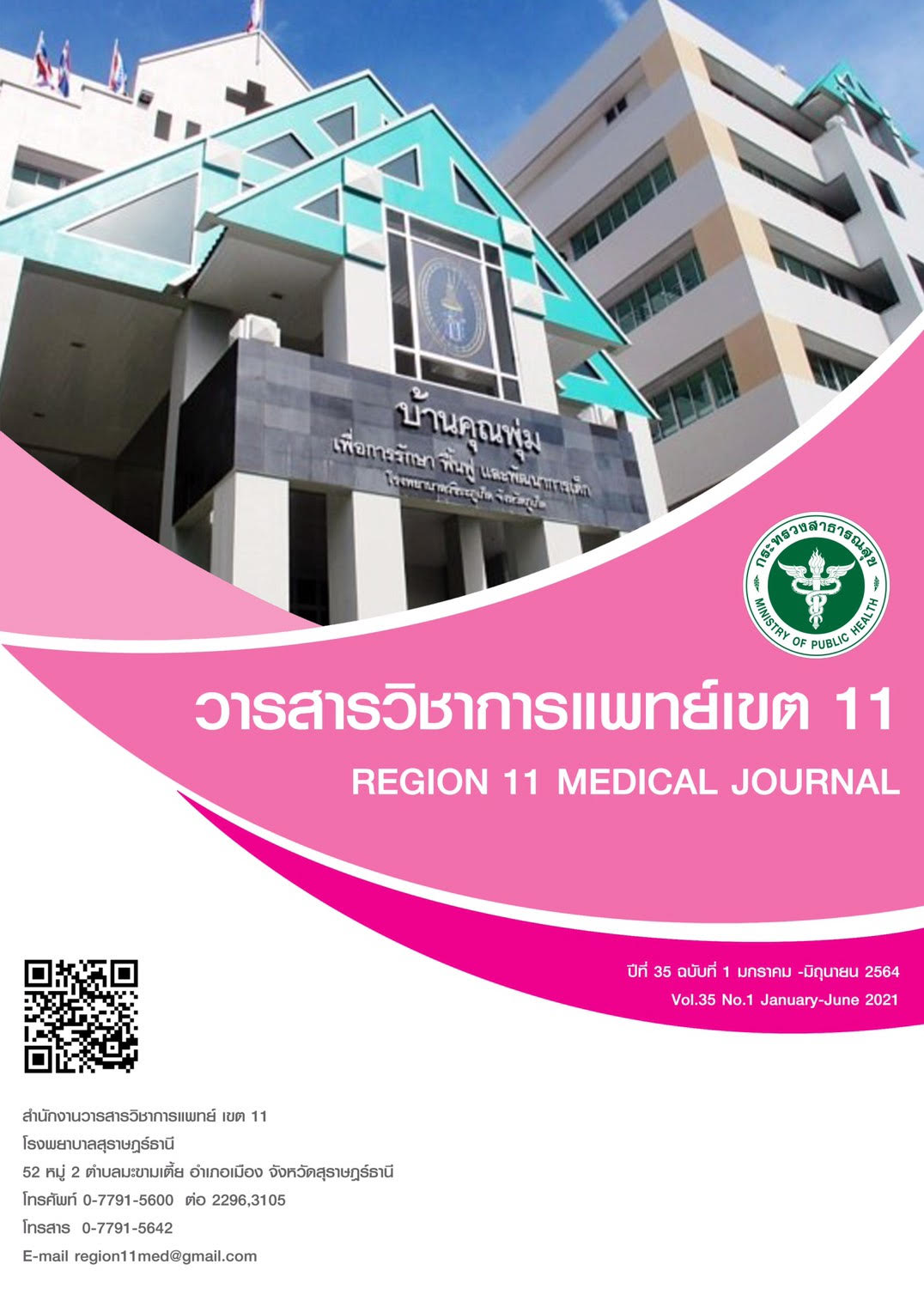Characteristics of neonatal sepsis in Phang-nga Hospital
Keywords:
neonatal sepsis, newbornAbstract
Abstract
Background: Neonatal sepsis is the major cause of mortality in newborn. If we have the good guidelines and treatment that can reduce mortality rate of neonatal sepsis.
Objectives: To study Characteristics of neonatal sepsis in Phang-nga Hospital about incidence, clinical manifestations and laboratory results of neonatal sepsis.
Method: This study was a retrospective review in neonates whom aged less than 28 days after births and were diagnosed neonatal sepsis according to WHO 2016 in Phang-nga hospital in the period of 1 January 2017 to 31 May 2020.
Results: The results showed incidence of neonatal sepsis was 37 per 1000 live births divided into 66.1% of EOS and 33.9% of LOS. The most common clinical presentation of EOS was Respiratory system 65.4% and LOS was Body temperature instability 73.8%. Basic laboratory investigations were show normal range but thrombocytopenia found in fungal infections. Blood culture were true positive 12.5% and the common pathogen was Methicillin-resistant coagulase negative Staphylococci (MRCONS) (25%) which resistance to all in Beta-lactam drugs but still has susceptibility to Vancomycin.
Conclusion: In Phang-nga hospital, early onset neonatal sepsis was more common than late onset neonatal sepsis. The most common Clinical manifestation in EOS and LOS were Respiratory system and Body temperature instability, respectively. Basic laboratory investigation showed normal range in neonatal sepsis so the precise clinical diagnosis and risk factor are important. Vancomycin should be selected as part of the treatment in LOS.
References
เอกสารอ้างอิง
Fuchs A, Bielicki J, Mathur S, Sharland M, Van Den Anker J. Antibiotic use for sepsis in neonate and children: 2016 evidence update. WHO Reviews. 2016.
Amare D, Mela M, Dessie G. Unfinished agenda of the neonates in developing countries: magnitude of neonatal sepsis: systematic review and meta-analysis. Heliyon. 2019;5(9):e02519.
Thatrimontrichai A. Neonatal sepsis in Thailand. Folia Medica Indonesiana. 2018;54(4):306-10.
ศรัญญา ศรีจันทร์ทองศิริ, ไกลตา ศรีสิงห์, จิรนันท์ วีรกุล.ปัจจัยเสี่ยงที่มีความสัมพันธ์กับการติดเชื้อในกระแสเลือดของทารกแรกเกิดในโรงพยาบาลมหาวิทยาลัยนเรศวร ปี2558. วารสารสาธารณสุขศาสตร์. 2558;45(3):256-71.
สุนันทา จินดารัตน์, ปัจจัยเสี่ยง อาการและอาการแสดงทางคลินิก การตรวจทางห้องปฏิบัติการ และการรักษาภาวะติดเชื้อในทารกแรกเกิดที่คลอดในโรงพยาบาลอู่ทองจังหวัดสุพรรณบุรี, วารสารสมาคมเวชศาสตร์ป้องกันแห่งประเทศไทย, 2558;5(1):28-41
Getabelew A, Aman M, Fantaye E, Yeheyis T. Prevalence of neonatal sepsis and associated factors among neonates in neonatal intensive care unit at selected governmental hospitals in Shashemene Town, Oromia Regional State, Ethiopia, 2017. International journal of pediatrics. 2018;2018.
Al-Matary A, Heena H, AlSarheed AS, Ouda W, AlShahrani DA, Wani TA, et al. Characteristics of neonatal Sepsis at a tertiary care hospital in Saudi Arabia. Journal of infection and public health. 2019;12(5):666-72.
El Hassani SeM, Berkhout DJ, Niemarkt HJ, Mann S, De Boode WP, Cossey V, et al. Risk factors for late-onset sepsis in preterm infants: a multicenter case-control study. Neonatology. 2019;116(1):42-51
Abdellatif M, Al-Khabori M, Rahman AU, Khan AA, Al-Farsi A, Ali K. Outcome of Late-onset Neonatal Sepsis at a Tertiary Hospital in Oman. Oman medical journal. 2019;34(4):302-7.
Guo J, Luo Y, Wu Y, Lai W, Mu X. Clinical characteristic and pathogen spectrum of neonatal sepsis in Guangzhou city from June 2011 to June 2017. Medical Science Monitor: International Medical Journal of Experimental and Clinical Research. 2019;25:2296-304.
Pokhrel B, Koirala T, Shah G, Joshi S, Baral P. Bacteriological profile and antibiotic susceptibility of neonatal sepsis in neonatal intensive care unit of a tertiary hospital in Nepal. BMC pediatrics. 2018;18(1):208.
Gao K, Fu J, Guan X, Zhu S, Zeng L, Xu X, et al. Incidence, bacterial profiles, and antimicrobial resistance of culture-proven neonatal sepsis in south China. Infection and Drug Resistance. 2019;12:3797-805.
Hammoud MS, Al-Taiar A, Al-Abdi SY, Bozaid H, Khan A, AlMuhairi LM, et al. Late-onset neonatal sepsis in Arab states in the Gulf region: two-year prospective study. International Journal of Infectious Diseases. 2017;55:125-30.
Jiang Y, Kuang L, Wang H, Li L, Zhou W, Li M. The clinical characteristics of neonatal sepsis infection in Southwest China. Internal Medicine. 2016;55(6):597-603.
Puopolo KM, Benitz WE, Zaoutis TE, Diseases CoI. Management of neonates born at≥ 35 0/7 weeks’ gestation with suspected or proven early-onset bacterial sepsis. Pediatrics. 2018;142(6):e20182894.
Downloads
Published
How to Cite
Issue
Section
License
Copyright (c) 2021 Region11Medical Journal

This work is licensed under a Creative Commons Attribution-NonCommercial-NoDerivatives 4.0 International License.






